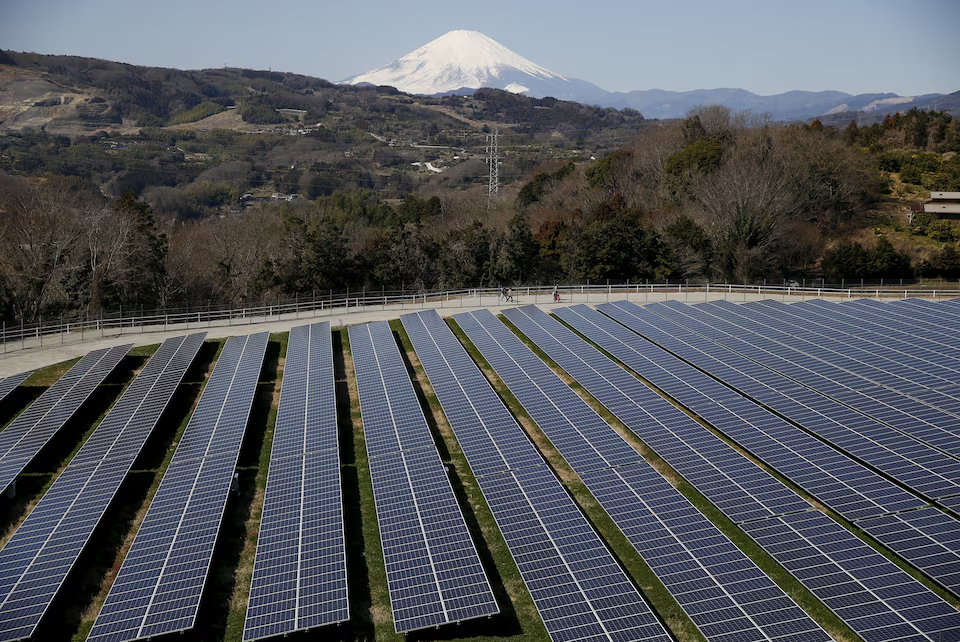Fossil fuels generated a record low share of Japan’s utility-scale electricity supplies over the first half of 2025, marking an important milestone in the energy transition momentum of one of the world’s largest fossil fuel consumers.
Japan is a top-10 consumer and importer of coal, natural gas and crude oil, which are used to generate a majority of the energy needed in the world’s fourth-largest economy.
However, the share of fossil fuels has steadily declined within Japan’s electricity generation, and accounted for less than 60% of utility-scale electricity supplies for the first time during January to June, data from Ember shows.
Clean energy sources – especially solar farms and nuclear power plants – have supplied the remaining electricity, and have sharply outpaced the growth in fossil fuel power sources so far this decade.

If clean electricity supplies continue to expand at the average rate seen since 2019, and fossil fuel supplies continue to contract at the pace seen over that same period, then clean electricity will surpass fossil electricity supplies by 2033.
The prospect of home-grown clean energy sources supplying a majority of Japan’s electricity within the next decade will be a cause for concern for fossil fuel exporters, who have relied heavily on Japan’s demand growth for decades.
CLEAN RECOVERY
Japan’s clean electricity supplies during January to June totalled 188 terawatt hours (TWh), Ember data shows.
That total is 47% more than during the same months in 2019, and marks the highest clean supply output level during the opening half of the year in over a decade.
However, clean electricity supplies remain well below their all-time peak set in the early 2000s due to the still-diminished level of nuclear power generation in the country following the 2011 Fukushima disaster.

Worries about the safety of nuclear power sparked widespread shuttering of Japan’s nuclear fleet since 2011, and nuclear electricity supplies in 2024 remained roughly 70% below where they were in 2010, the year before the Fukushima meltdown.
However, while nuclear has remained largely sidelined, Japanese utilities have rapidly lifted generation from other clean sources over the past decade or so.
Since 2010, solar generation has scored a 25-fold rise, while output from wind farms and bioenergy power plants has more than doubled.

These clean power additions have allowed non-nuclear clean electricity supplies to scale new records in eight of the past 10 years, and lifted clean electricity’s share of the total generation mix to 31% in 2024 from just 12% in 2012.
That clean generation share has jumped to an average of 41% for the first half of 2025, thanks to record output from wind farms and bioenergy plants, and a continuing recovery in nuclear plants as reactors gradually return to service.
FOSSIL FIX
Japan’s utilities have made cuts to fossil fuel use in electricity generation as they have boosted supplies of clean power.
The total amount of electricity generated from natural gas plants during January to June of 2025 was the lowest for that six-month period since at least 2019, as high natural gas prices stifled gas use in the country.

Coal-fired generation climbed by around 4% from the same months in 2024 to make up the drop in gas power, and overall fossil fuel electricity supplies were largely flat compared to a year ago.
The cuts to fossil fuel use are more evident compared to the generation levels seen during the first half of 2019.
Coal-fired electricity supplies in the first half of 2025 were 9% below those of the first half of 2019, while gas-fired electricity output was 25% lower.
Given Japan’s ambitions to cut greenhouse gas emissions by 46% by 2030 from 2013 levels – when there was a surge of fossil fuel power generation – additional reductions to coal and gas-fired power are expected in the coming years, alongside the shuttering of outdated fossil power plants.
Between 2019 and 2024 Japan’s fossil fuel electricity supplies contracted by an average of 3% a year, which if sustained would result in a 30% drop in fossil generation by around 2040.
At the same time, clean electricity supplies have expanded by around 6% a year since 2019, which if sustained would result in a doubling in clean electricity supplies by around 2036.

More importantly for climate trackers, that growth pace would mean that clean electricity supplies would likely account for a majority share of Japan’s electricity from 2033 onwards.
For fossil fuel exporters, however, the diminishing role of coal and gas in the electricity system of such a major economy represents a threat to their long-term prospects, especially as other major economies also phase out fossil fuel use.
Source: Reuters

